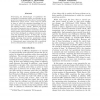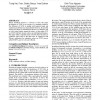MICAI
2010
Springer
14 years 25 days ago
2010
Springer
The full deployment of service robots in daily activities will require the robot to adapt to the needs of non-expert users, particularly, to learn how to perform new tasks from “...
AAAI
1996
14 years 3 months ago
1996
Overcoming the disadvantages of equidistant discretization of continuous actions, we introduce an approach that separates time into slices of varying length bordered by certain ev...
NIPS
2008
14 years 3 months ago
2008
Recently, fitted Q-iteration (FQI) based methods have become more popular due to their increased sample efficiency, a more stable learning process and the higher quality of the re...
AIPS
2008
14 years 4 months ago
2008
When controlling an autonomous system, it is inefficient or sometimes impossible for the human operator to specify detailed commands. Instead, the field of AI autonomy has develop...
ECML
2006
Springer
14 years 6 months ago
2006
Springer
We target the problem of closed-loop learning of control policies that map visual percepts to continuous actions. Our algorithm, called Reinforcement Learning of Joint Classes (RLJ...
GECCO
2007
Springer
14 years 8 months ago
2007
Springer
Wilson introduced XCSF as a successor to XCS. The major development of XCSF is the concept of a computed prediction. The efficiency of XCSF in dealing with numerical input and con...


